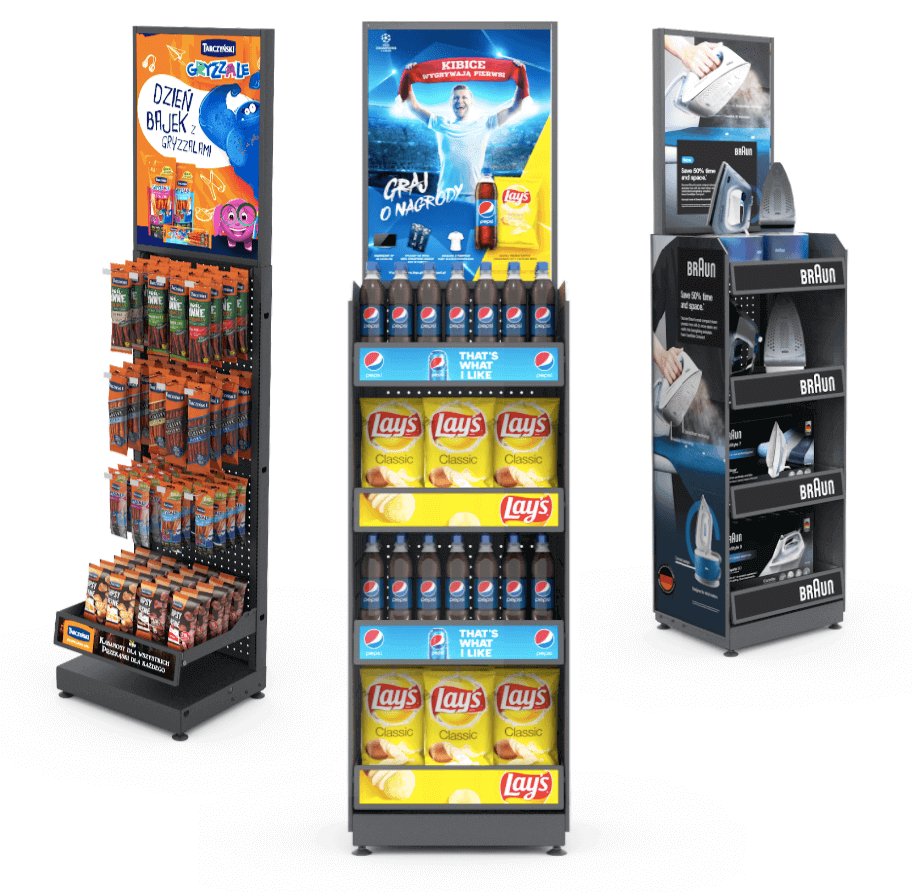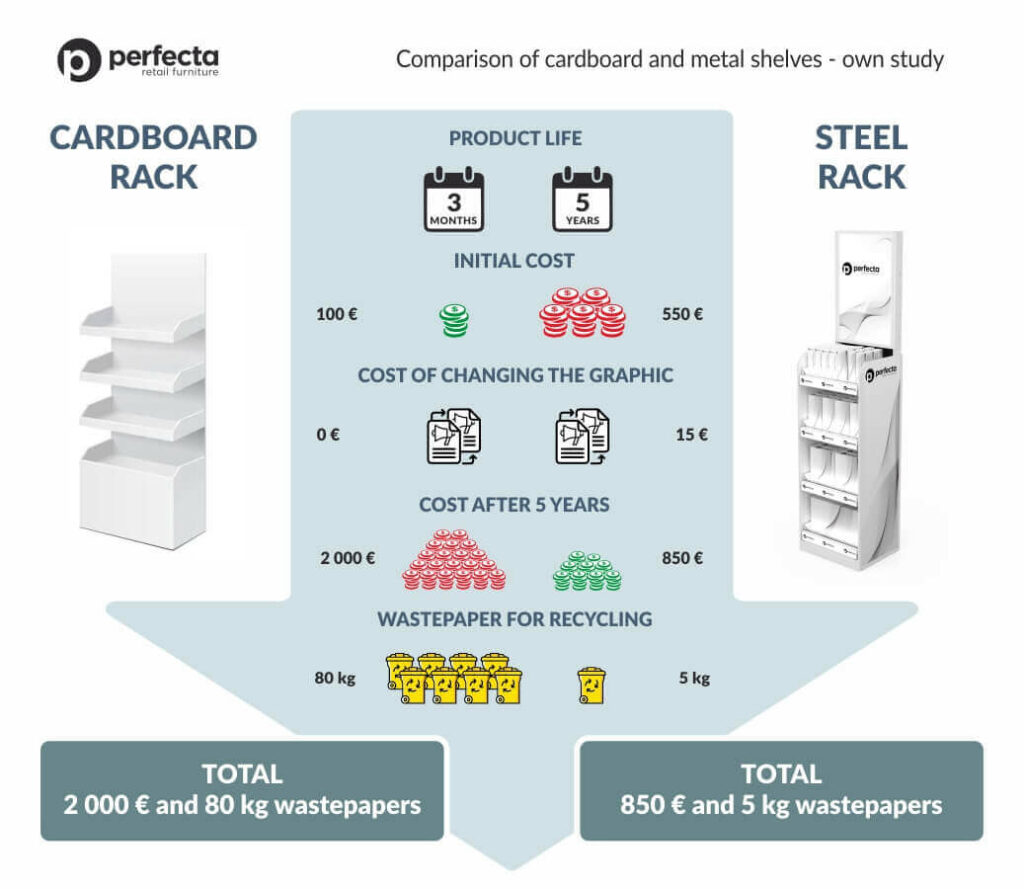Reusable displays versus disposable cardboard shelves. Reuse idea.
Is it possible to reconcile the needs related to ecology with the needs resulting from the specific work of a retail chain or a manufacturer of FMCG products? The advertising industry is often faced with the choice of the lesser evil, involving a dilemma “should it be cheap or eco-friendly?” Often acting under pressure to achieve high efficiency at low cost, it resorts to the use of cheap materials that generate substantial amounts of waste.
But is waste the only problem? Are we not also generating unnecessary increases in energy or fuel consumption? This translates into costs that we all bear, paying for them in the price of the product.
Changing shopping habits and increased ecological awareness of customers entail changes in the approach of retail chains and their suppliers to packaging and entire logistics processes. This change is already visible to the naked eye, both in large chains and in small local shops. But the problem of waste is not only related to packaging; it is also time to look at other aspects and processes in the trade that can be improved and managed more consciously.
Point of sale advertising – waste generator
Let’s look at in-store advertising, or the so-called trade marketing – the branch of the advertising industry responsible for promoting products at points of sale, which is handled by Perfecta Retail. We all know it from our daily shopping – the aisles cluttered with advertising racks. Every day we slalom around them with the shopping trolley. There are too many of them, and most of them are disposable, usually made of cardboard. A cluttered space is not aesthetically pleasing, and often overloaded cardboard displays endanger customers.

Why is it so? In-store advertising, especially in the FMCG (fast moving consumer goods) category, must be geared to frequent change – seasonal campaigns, changing trends and the rules of brand collaboration with networks. Everyone wants to stand out, designers and marketers are outdoing themselves with creative ideas. But the truth is that all promotional racks are ultimately remarkably similar, meaning they have shelves and a topper and sides with graphics.



Therefore, cardboard solutions are most often chosen, as they are cheap to produce and easy to dispose of. Their manufacturers often emphasize their environmental friendliness due to their recyclability. But is cardboard really green? And is it really that cost-effective?
All we know is that it’s just convenient because once it’s used up, you just crush it and throw it in the bin.
Recycling is neither profitable nor green
This perverse phrase has its justification. Vast amounts of energy and water are used to process wastepaper (and other raw materials as well). Therefore, additional costs are needed to reuse wastepaper to make new cardboard or paper. In addition, wastepaper treatment processes consume enormous amounts of chemicals needed for de-inking, stripping of film and laminates, etc.
Finally, cardboard cannot be recycled indefinitely. Recycled material can make up a maximum of 50% of the share of new paper production, and wood fibres, after being recycled several times, are no longer suitable for production and must be disposed of, i.e., incinerated.
Don’t recycle – reuse
To have a truly sustainable economy, the change of approach is needed. Instead of generating an ever-increasing amount of waste, even recyclable waste, it is better to act to gradually reduce its amount. It’s not enough to replace plastics in the production of packaging or advertising materials with paper or foil, which will either end up in a landfill as non-recyclable waste or be recycled at a significant cost of energy. This way we are simply creating waste of a different type. The trick is to design reusable solutions that will last for years instead of being discarded after one use.
And what about the seasonality of advertising?
How to use less material, but at the same time be able to run different advertising campaigns from month to month or year to year? You should take the right approach when designing your marketing equipment. Its design and functionality can be planned in such a way that it is reusable, while still being adaptable to various products and changing advertising campaigns. This eliminates the need to produce more equipment for subsequent promotional campaigns. In this case, it makes sense to use steel, a raw material that is much stronger and at the same time very recyclable.
Steel production
Let’s be honest: steel production, like cardboard, is not eco-friendly. It consumes vast amounts of energy and is high carbon intensive. Enormous quantities are produced all over the world every year.
However, steel is an extremely recyclable material. It retains all its natural properties when re-used. It is therefore characterized by very high durability and strength. Steel recycling is a way to save substantial amounts of energy and materials. At the same time, work is underway to implement large-scale production of zero-emission steel. The first batches of the raw material produced in this way are already used by the factory of a well-known Swedish car brand.
But it would not be profitable to use steel for marketing equipment used for a brief period. Continuous recycling of steel would entail a dynamic increase in CO2 emissions and production costs. It must therefore be designed to be reusable, with modular solutions being the most effective. That is why Perfecta, following the adopted GoGreen strategy, has developed a solution which is durable and at the same time offers the possibility of a fast replacement of elements and communication in time for the next promotional campaign.
Sustainability with Perfecta
Check out our solutions and see for yourself that an investment in consciously designed sales support equipment can not only be green, but also economically beneficial.
An example of a solution that perfectly fits in with the trend described in the article is our promotional rack, which is made of 90% steel, with a minimal amount of plastic. But its main value in terms of sustainability is that it can be used repeatedly for various products, brands and advertising campaigns.
Find out more on the product page

The steel structure with special perforations makes it possible to change the arrangement and height of the shelves and thus adapt them to changing stock. This is not possible with cardboard shelving, and difficult and not very convenient in case of wooden racks.

This way, you can use the same shelf to sell breakfast cereals today and cosmetics tomorrow. The arrangement of the shelves is changed without the use of any tools. Appropriately designed elements for mounting graphics allow for equally quick and easy exchange of advertising content, branding or price lists.
Savings and ecology
Thus, by deciding to invest in a modular steel advertising rack, you are contributing, on the one hand, to reducing the environmental impact of the retail industry – by reducing the amount of waste, including waste to be recycled – and, on the other, you are arming yourself with an effective advertising tool that will increase sales. Instead of replacing the cardboard shelves that flood the aisles of our shops, and then the warehouses and wastepaper sorting rooms every month, you can set up tidy, durable, and aesthetically pleasing metal shelving that will tidy up your sales space and give you the opportunity to run multiple advertising campaigns using the same display. Less waste and less logistics mean savings and eco-friendliness.
With a standard shelf with interchangeable graphics, you can focus on designing effective communication. This benefits both the manufacturers – brand owners and product suppliers – and the retail chains. The former will have an easier time designing and implementing campaigns, while the latter will tidy up their shops and reduce the amount of waste that needs to be managed. But in the end, it is the customers who benefit the most, with their shopping experience gaining quality.
Most importantly, you save money. Assuming that you are running regular advertising campaigns in the retail chains, after just 1.5 years, you will notice that the cost of producing six new cardboard displays will be more than that of a 1 metal display (assuming the change of campaign every 3 months).
Reuse, in life and in business.
In conclusion, changing our habits to be more eco-friendly according to the reuse philosophy can also have a positive economic impact on the retail industry. Once again, it turns out to be a myth that green solutions are, as a rule, more expensive. It is only seemingly more profitable to produce more “cheap” disposables instead of investing in durable and thoughtfully designed reusable solutions.
You are also welcome to visit our Facebook profile oraz YouTube channel.




